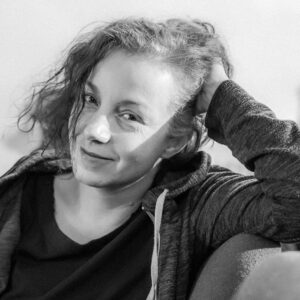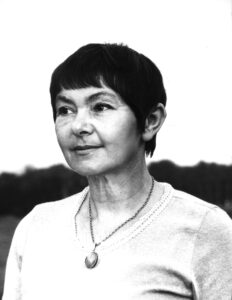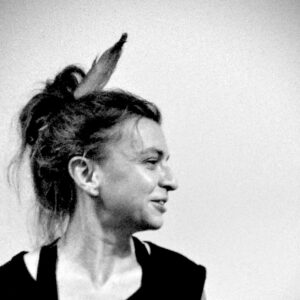Ewa Ciepielewska
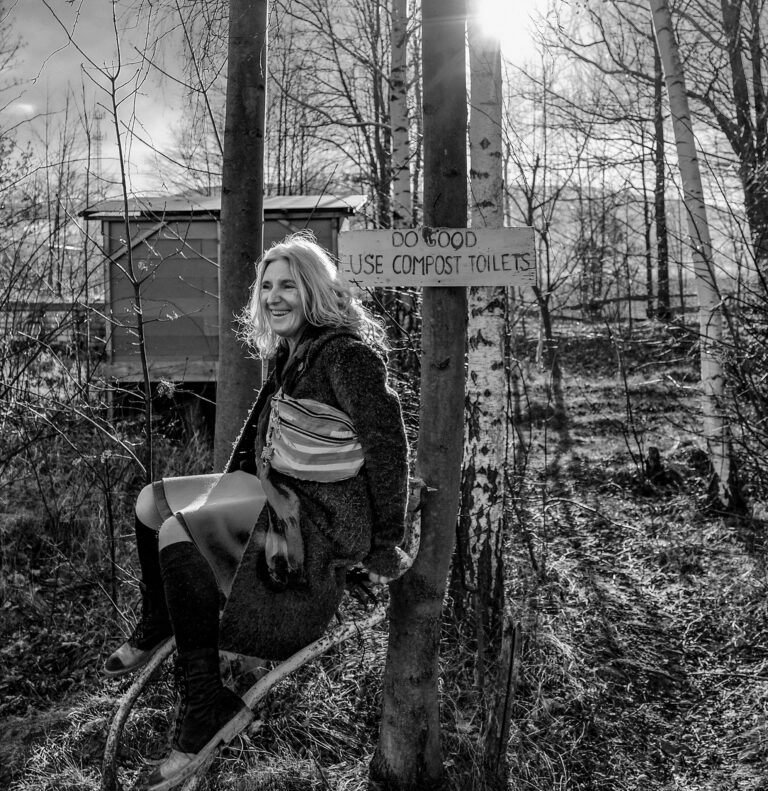
– born in 1960 in Wałbrzych – painter, performer, nature lover. She studied at the Academy of Fine Arts in Wrocław, where she obtained her diploma in 1984 in the studio of Prof. Konrad Jarodzki with diploma supplement from the Department of Visual Knowledge under Prof. Leszek Kaćma. Associated with the LUXUS group from its inception until today. Founder of the VOLANS association, which supports contemporary art and young artists. Since 2008, she has participated annually in the Royal River Rafting on the Vistula, and was awarded the Order of the Knight of the Vistula in 2020 for her activity. She has co-created a residency project on the river since 2016, called FLOW, which links her artistic practice to the Vistula and other rivers. In 2019, she was awarded the Katarzyna Kobro Prize. In 2022, she was the winner of the international Allegro Prize competition organised by Contemporary Lynx. She has works in private and museum collections: National Museums in Krakow, Wrocław, Warsaw, the Jerke Museum in Recklonghausen.
We love the wild Vistula!
We, creatures metabolically and spiritually linked to the Vistula, desire a river that is free and wild.
A river is a living, dynamic and self-organising entity
It does nothing and still nothing is undone
I am the river and the river is me
The Whanaganui, Ganges and Yamuna rivers have legal personality and the status of living entities
The Vistula and other rivers have the same right to be recognised as living entities
Dolphins are non-human persons in India
All sentient beings have the right to autonomy, mutual respect and place of residence
Altruistic Earthlings are going all the way!
The independent Vistula and the Vistula people!
We love the wild Vistula!
As humans, we crave sleeping outdoors, swimming naked, getting wet in the rain, warming ourselves by the night fire, the morning mist, a sky with stars, singing birds, doing things ordinary and extraordinary
As sentient beings we all have the right not to be someone else’s property
Water shrew, beaver, moose, salmon, white-tailed eagle, otter, sturgeon, sea trout, tern, vole, plover, oystercatcher and paramecium have their own affairs and lives
Old river beds for catfish and that’s it!
Vistula without barriers, dams, steps, sluices and shoddy barrages
Fish migrate freely and in their own way
Only beavers build on the river
Free access to water, air and land for all
We love the wild Vistula!
An irregular flow, turbulent and full of whirlpools, mixing and oxygenating, life boils unstoppably
Streams and mountain rivers don’t need regulation or obstruction,
More forests: lush beech trees regulate water levels in rivers, branches to the sky!
Sand, rocks, underwater sandbanks, plant roots, aquatic flora and filtering mussels clean the river water
Psammon live at the moving bases
Swamps, marshes, oxbow lakes, rushes, riparian forests, wet meadows, bogs maintain clean water supplies
There is no day without water!
There is nothing without insects and microorganisms
Cheers to the self-sustaining river organisms!
Everything everywhere full of everything!
The wellspring embraces the whole world
To wildness, love and adventure!
Radical joy, telepathic spa
Take your own sacrament
The Whole Earth as a National Park!
Agnieszka Brzeżańska/Ewa Ciepielewska, 2018
I share this joint manifesto – mine and Agnieszka Brzeżanska’s – because I consider this text to be a climatically and socially important statement by female artists who collaborate in very specific conditions – on a boat journey, or in the context of a residency for a post-intervention exhibition. I join forces with others to act, not only because it exerts a greater impact on the environment, but also because it offers mutual support to those who collaborate. That kind of format is also important in creating new multidisciplinary connections, and in finding consensus between different attitudes and intentions, in order to achieve a common goal.
I see art as a way of being in the world. I treat it as a profession and as my identity:
How to present oneself to the world as a person? How to communicate with others? How can one fulfil the dream of a harmonious, peaceful coexistence of all sentient beings through one’s personal commitment? How to satisfy one’s sense of existence?
These questions are the backdrop for a network of connections emerging over time and in different places, based on the principles of sisterhood, curiosity, emotional and intellectual engagement, affinity of goals. They are the result of a personal history, they emerge because of empathy towards others and the impossibility of remaining indifferent to offers of collaboration. They encourage artistic experimentation that blurs the cogs of the algorithm123.
For society, the artist is someone different, a crazy, non-normative person who embodies fears and dreams. As such, society allows the artist more freedom of behaviour and expression than it does for others. He or she is something of a modern-day jester – and can fulfil his or her role by loudly declaring that ‘the king is naked’. I am an advocate of such an attitude and try to act purposefully in support of the values I hold dear.
I am inspired by other people who are able to happily devote all their energies to the realisation of their dreams and consequently become voluntary advocates and experts in a cause to which they have attached their whole lives, such as Jane Goodall, the chimpanzee researcher. I see my practice as an ongoing process in which the decisions I make and the actions I take, and the situations beyond my control, have consequences. In this flux, individual works emerge from a multiplicity of threads.
Initially, only individual achievements in the field of art were important to me. During my studies, however, due to exceptional circumstances – the declaration of martial law and its repercussions – I joined forces and creative invention with a group of friends, establishing the LUXUS group, with whom I have been active to this day4. In the 1990s I collaborated with the Krakow-based magazine “Piątek Wieczorem” and founded, with Magda Mosiewicz, the Blue Panthers tandem, and later, with Myriam Prongue, the VOLANS association, supporting young artists56. After 2000, I started navigating a wooden boat, initially recreating the rafting tradition of the spring float to Gdansk, and since 2016, together with Agnieszka Brzeżanska, I have been carrying out the FLOW project, in which we invite artists, curators and friends to a unique residency taking place on an open-air boat sailing upstream on the Vistula River from Gdansk78.
Art is a discipline that allows one to achieve goals that do not only have an aesthetic purpose. It has an important therapeutic function, as well as an educational and cognitive one. As a rule, activities in the field of art go beyond the status quo and suggest a different vision of reality as well as innovative ways of being a part of it. For example, the boat residencies are a pretext for getting closer to nature, not only to be artistically inspired and relaxed, but also to become, through such an experience, conscious allies of the living, dynamic, self-organising rivers that are essential for maintaining water balance in the ecosystem. In effect, this aspect of artistic activity has a direct impact on our reality910.
I am an active person both professionally and socially, and I always have something to do, but I occasionally remove myself to a voluntary retreat that allows me to maintain my enthusiasm to keep going. I have a family, three grown-up children and lots of friends. I ride my bike and have been a vegetarian for over thirty years (although I have to admit it is not very restrictive, sometimes I submit to the force of hunger and eat what is available).
My artistic practice does not interfere with my personal life, it is integrally tied to it. But it wasn’t always this way. I can see by my successive children how this interplay has affected their personal development. The inexperienced mother of twenty was someone different from the mother of twenty-eight, and I was still different as a mother ten years later. In marriage we were (my husband is dead) equal partners – I realise that this was not and is not a common phenomenon in Poland. I see the image of a woman-mother as someone who is tender, caring, understanding, but in some ways resolute. This is what my mother was like, but that was something I had to grow up to on my own, because I was stubborn and self-willed, something my parents allowed me to be.
It is very important for the self-esteem of women artists-mothers and caregivers-to receive systemic support from the state – both material and psychological. There is also a need for measures and programmes to make society aware of the importance and need for such a role that these people play. This applies to all women mothers and caregivers, but also to men fathers and caregivers, who do real physical, psychological, educational work, often sacrificing personal wants for the good of the children.
Over the forty years during which I have been professionally active as an artist, I have seen that women artists are gaining an increasingly strong foothold in culture and that their voices are being heard ever more clearly. We are taking up, as women, the topics most relevant to the life of the planet as a whole. There are a lot of women at the FLOW residency, when the traditional rafting down the river is usually done by men. Female artists are bold and act out of the box, which often shocks the public accustomed to a gendered division of roles. Perversely, this is what makes their voice better heard, and although it often arouses hostile reactions and even legal repercussions, it jolts society out of its sense of the immutability of prevailing norms (which, although no longer compatible with the conditions of social life, continue to function, perhaps only by the force of political inertia)11.
For me, politics is a way of finding social consensus. Unfortunately, in our country it is often a tool of cynical manipulation. This, of course, affects our daily and artistic lives and spurs a reaction. As the author of the FLOW residency, I belong to the Save the Rivers Coalition, which is made up of various local government organisations interested in the well-being of Polish nature. I speak out against the policy of paving rivers with concrete and their harmful regulation, erecting dikes, destroying beaver dams, cutting down forests, thickets and draining marshes. I also oppose the industrial breeding of animals12.
I love our country – nature is gentle here, the landscape is diverse, we still have vast resources of various raw materials and no shortage of living space – all of which means that a careful and sensitive economic policy and nature-friendly laws would allow a prosperous and sustainable life for all inhabitants, human and non-human. A good social policy would make it possible to heal the wounds caused by the turbulent history of the 20th century and the uprooting of a large part of the population (I myself come from Lower Silesia), which has had enormous social consequences to date.
The Polish woman, the Polish mother are the national templates of femininity. This undoubtedly refers to the role of the woman giving and sustaining life regardless of the historical context. I understand and accept this, but I do not limit myself to this aspect. The fact that I love my country does not mean that I limit my love for the world to its national borders – on the contrary, I am in favour of the abolition of frontiers between states and for the free migration of people and animals, all the more so because, in the face of a climate catastrophe, the only way to solve the problem is global cooperation between the inhabitants of the entire planet. We are, first and foremost, Earthlings; it is under the flag of Earth that our SOLNY galley sails during the FLOW residency13. As living organisms, human and non-human, we have the same needs: access to water, air, sun, minerals; we are subject to the same rules of life and death. I also treat my artistic statements, which often refer to the coexistence of different species, as political statements. Art does not function in a vacuum – the home of culture is Nature14.
The text was written in collaboration with Bogna Stefańska (2022).
1Image: “Water Opening”, plain-air in the old Solvay Soda Plant and site specific action in the stone-pit mine Zakrzówek, Cracow, 1995. Courtesy of the artist.2Image: “Water Opening”, plain-air in the old Solvay Soda Plant and site specific action in the stone-pit mine Zakrzówek, Cracow, 1995. Courtesy of the artist.
3Image: “Water Opening”, plain-air in the old Solvay Soda Plant and site specific action in the stone-pit mine Zakrzówek, Cracow, 1995. Courtesy of the artist.
4Image: Ewa Ciepielewska, Femen, acrylic paint on canvas, 2012. Courtesy of the artist.
5Image: Ewa Ciepielewska, Russian Dutch, acrylic paint on canvas, 1994. Courtesy of the artist.
6Image: Ewa Ciepielewska, Rabbit Father, acrylic paint on canvas 1993. Courtesy of the artist.
7Image: Jadwiga Sawicka, flag The Heart of the Country, 2018, photo by Ewa Ciepielewska. Courtesy of the artist.
8Image: Flow/Przepływ, 2022, photo by Magdalena Lazar. Courtesy of the artist.
9Image: Flow/Przepływ, “How to talk with birds, trees, fish, shells, snakes, bulls and lions” exhibition view, Hamburger Bahnhof, 2018. Courtesy of the artist and Hamburger Bahnhof.
10Image: Ewa Ciepielewska, “Vistula. Re-creation” exhibition view, Cracow Museum, 2022. Courtesy of the artist and Cracow Museum.
11Image: Ewa Ciepielewska, Lady with a Weasel, template, 1989/2011, photo by Ewa Ciepielewska. Courtesy of the artist.
12Image: Ewa Ciepielewska, canvas sail We Love the Wild Vistula!, 2018. Courtesy of the artist.
13Image: Ewa Ciepielewska, photo Under the Earth Flag. Courtesy of the artist.
14Image: Ewa Ciepielewska, Return of the Catfish, acrylic paint on canvas, 2020. Courtesy of the artist.
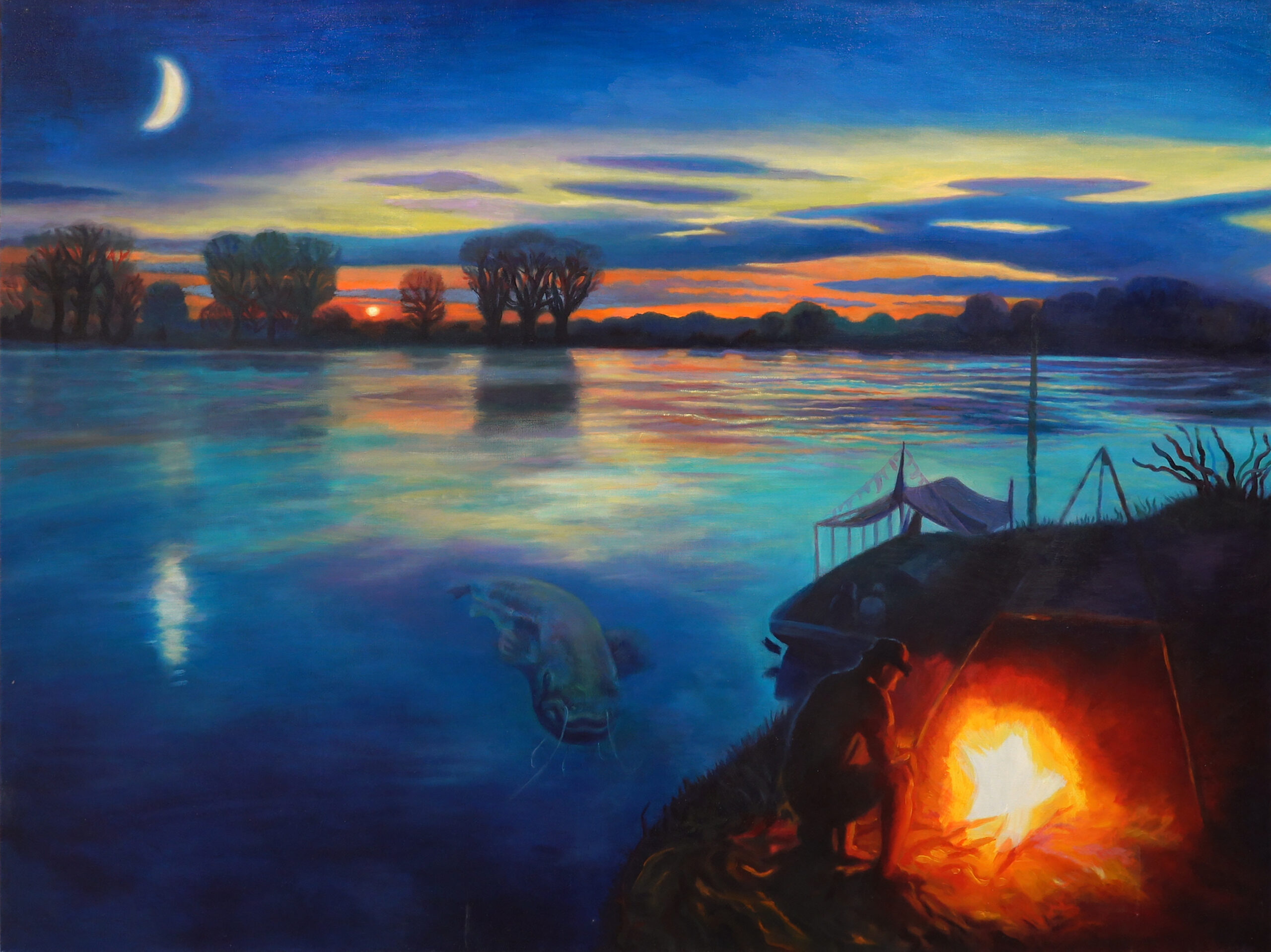
– urodzona w 1960 roku w Wałbrzychu – malarka, performerka, miłośniczka przyrody. Studiowała na wrocławskiej ASP, gdzie uzyskała dyplom w 1984 r. w pracowni prof.Konrada Jarodzkiego, aneks w Katedrze Wiedzy Wizualnej u prof. Leszka Kaćmy. Związana z grupą LUXUS od początku jej powstania do dzisiaj. Założycielka stowarzyszenia VOLANS wspierającego sztukę współczesną i młodych artystów. Od 2008 r. corocznie uczestniczy w Królewskim Flisie na Wiśle, za swoją aktywność odznaczona Orderem Kawalera Wisły w 2020 r. Współtwórczyni projektu rezydencji na rzece od 2016 r., pod nazwą FLOW/Przepływ, który artystyczną praktykę łączy z rzeką Wisłą i innymi rzekami. W 2019 r. otrzymała nagrodę im. Katarzyny Kobro. W 2022 została laureatką międzynarodowego konkursu Allegro Prize organizowanego przez Contemporary Lynx. Prace w kolekcjach prywatnych i muzealnych: Muzeum Narodowe w Krakowie, Wrocławiu, Warszawie, Muzeum Jerke w Recklonghausen.
W dzikiej kochamy się Wiśle!
My, istoty metabolicznie i duchowo związane z Wisłą pragniemy rzeki wolnej i dzikiej
Rzeka jest bytem żywym, dynamicznym i samoorganizujacym się
Nic nie robi, a nic nie jest niezrobione
Ja jestem rzeką, a rzeka jest mną
Rzeki Whanaganui, Ganges i Jamuna mają osobowość prawną i status bytów żywych
Rzeka Wisła i inne rzeki mają takie samo prawo do uznania je za byty żywe
Delfiny są w Indiach osobami niebędącymi ludźmi
Wszystkie czujące istoty mają prawo do niezależności, wzajemnego szacunku i miejsca zamieszkania
Altruistyczni Ziemianie idą na całość!
Niepodległa Wisła i Wisłacy!
W dzikiej kochamy się Wiśle!
Jako ludzie pragniemy spania pod gołym niebem, pływania nago, moknięcia na deszczu, grzania się przy nocnym ognisku, porannej mgły, nieba z gwiazdami, śpiewania ptaków, robienia rzeczy zwykłych i niezwykłych
Wszyscy jako czujące istoty mamy prawo do niebycia czyjąś własnością
Rzęsorek rzeczek, bóbr, łoś, łosoś, bielik, wydra, jesiotr, troć, rybitwa, certa, sieweczka, ostrygojad i pantofelek mają swoje sprawy i swoje życie
Starorzecza dla sumów i basta!
Wisła bez barier, zapór, stopni, śluz i niedorobionych przepławek
Ryby migrują swobodnie i po swojemu
Na rzece budują tylko bobry
Swobodny dostęp do wody, powietrza i ziemi dla wszystkich
W dzikiej kochamy się Wiśle!
Przepływ nieregularny, turbulentny i pełen zawirowań, mieszanie i natlenianie, życie kipi niepowstrzymanie
Potoki i górskie rzeki nie potrzebują regulacji ani udrożniania,
Więcej lasów: bujne buczyny regulują poziom wody w rzekach, konary do nieba!
Piasek, kamienie, podwodne przykosy, korzenie roślin, wodne rośliny i filtrujące małże oczyszczają wodę rzeki
Psammon żyje u ruchomych podstaw
Bagna, mokradła, starorzecza, szuwary, lasy łęgowe, wilgotne łąki, torfowiska utrzymują zasoby czystej wody
Nie ma dnia bez wody!
Nic bez owadów i mikroorganizmów
Wiwat samodzielne organizmy rzeczne!
Wszystko wszędzie pełne wszystkiego!
Źródlana transmisja obejmuje cały świat
Za dzikość, miłość i przygody!
Radykalna radość, telepatyczne spa
Weź swój własny sakrament
Cała Ziemia Parkiem Narodowym!
Agnieszka Brzeżańska/Ewa Ciepielewska, 2018
Dzielę się wspólnym manifestem – moim i Agnieszki Brzeżańskiej – ponieważ uważam ten tekst za ważną w kontekście klimatycznym i społecznym wypowiedź artystek, które współpracują ze sobą w bardzo konkretnych warunkach – podczas przepływu łodzią, albo w kontekście rezydencji przy poplenerowych wystawach. Łączę się w działaniach z innymi, bo ma to większą moc oddziaływania na otoczenie, ale również daje wzajemne wsparcie współpracującym osobom. Taka forma ma również znaczenie dla tworzenia nowych wielodyscyplinarnych połączeń, a także w znajdowaniu konsensusu pomiędzy różnymi postawami i zamierzeniami, dla osiągnięcia wspólnego celu.
Przez sztukę rozumiem sposób bycia w świecie. Sztukę traktuję jako zawód i swoją tożsamość:
W jaki sposób przedstawić się światu jako osoba? Jak komunikować się z innymi? Jak można poprzez swoje osobiste zaangażowanie spełniać marzenia o harmonijnym, pokojowym współistnieniu wszystkich czujących istot? Jak usatysfakcjonować swoje poczucie sensu istnienia?
Te pytania są kanwą dla powstającej w czasie i w różnych miejscach sieci powiązań opartych na zasadach siostrzeństwa, ciekawości, emocjonalnego i intelektualnego zaangażowania, pokrewieństwa celów. Są wynikiem osobistej historii, pojawiają się z powodu empatii względem innych oraz niemożności pozostawania obojętną na propozycje współpracy. Skłaniają do artystycznego eksperymentu, który zaciera tryby algorytmu123.
Artysta jest dla społeczeństwa kimś innym, szalonym, nienormatywnym, który uosabia lęki i marzenia. Jako takiej osobie, społeczeństwo pozwala artyście na większą wolności zachowania i wypowiedzi, niż innym jego członkom. Jest kimś w rodzaju współczesnego błazna i może spełniać jego rolę głośno oświadczając, że „król jest nagi”. Jestem wyrazicielką takiej postawy i staram się działać w sposób celowy na rzecz bliskich mi wartości.
Inspirują mnie inni ludzie, którzy potrafią poświęcić z radością wszystkie swoje siły na realizację marzeń i w konsekwencji stają się w dobrowolnymi orędownikami i orędowniczkami, ekspertkami i ekspertami w sprawie, z którą związali całe swoje życie, jak na przykład. Jane Goodall, badaczka szympansów. Postrzegam swoją praktykę jako ciągły proces, w którym podejmowane przeze mnie decyzje i działania oraz niezależne ode mnie sytuacje mają swoje następstwa. W tym strumieniu, z wielości wątków wyłaniają się poszczególne prace.
Początkowo były dla mnie ważne tylko indywidualne osiągnięcia na polu sztuki, ale już w trakcie studiów, z powodu wyjątkowych okoliczności – ogłoszenie stanu wojennego i jego reperkusje – jako grupa przyjaciół połączyliśmy siły i twórczą inwencję, zakładając grupę LUXUS, z którą działam do dzisiaj4. W latach 90-tych współpracowałam z krakowskim magazynem „Piątek Wieczorem” oraz założyłam z Magdą Mosiewicz tandem Niebieskie Pantery, a następnie z Myriam Prongue stowarzyszenie VOLANS, wspierające młodych artystów56. Po roku 2000 zaczęłam pływać drewnianą łodzią, początkowo odtwarzając flisacką tradycję wiosennego spławu do Gdańska, a od 2016 wraz z Agnieszką Brzeżańską realizując projekt FLOW/Przepływ, w ramach którego zapraszamy artystów, kuratorów i przyjaciół na wyjątkową rezydencję odbywającą się na odkrytej łodzi płynącej Wisłą z Gdańska w górę rzeki78.
Sztuka jest dziedziną pozwalającą na osiągnięcie celów nie tylko estetycznych. Ma ważną funkcję terapeutyczną, a także wychowawczą i poznawczą. Działania na polu sztuki z zasady wykraczają poza obowiązujące status quo, żeby sygnalizować inną wizję rzeczywistości i oryginalne sposoby uczestniczenia w niej. Na przykład rezydencje na łodzi są pretekstem do zbliżenia z naturą nie tylko po to, aby się artystycznie inspirować i relaksować, ale również po to, by poprzez takie doświadczenie stać się świadomymi sojusznikami żywych, dynamicznych, samoorganizujących się rzek, które są niezbędne dla zachowania równowagi wodnej w ekosystemie. W efekcie taki aspekt artystycznej działalności wpływa bezpośrednio na naszą rzeczywistość910.
Jestem osobą aktywną zawodowo i towarzysko, zawsze mam coś do zrobienia, ale od czasu do czasu usuwam się na dobrowolne odosobnienie, które pozwala mi utrzymać zapał do dalszych działań. Mam rodzinę, trójkę dorosłych dzieci i mnóstwo przyjaciół. Jeżdżę na rowerze, od ponad trzydziestu lat jestem wegetarianką (chociaż muszę przyznać, że nie bardzo restrykcyjną, czasami podporządkowuję się sile głodu i zjadam to, co jest dostępne).
Moja praktyka artystyczna nie przeszkadza mi w życiu osobistym, jest z nim integralnie związana. Ale nie zawsze tak było. Po swoich kolejnych dzieciach widzę, jak te zależności wpłynęły na ich rozwój osobisty. Niedoświadczona dwudziestoletnia matka była kimś innym, niż matka dwudziestoośmioletnia, a jeszcze inna, jako matka, byłam dziesięć lat później. W małżeństwie byliśmy (mój mąż nie żyje) równouprawnionymi partnerami – zdaję sobie sprawę, że nie było to i nie jest w Polsce zjawisko powszechne. Obraz kobiety-matki to dla mnie osoba czuła, opiekuńcza, wyrozumiała, lecz w pewnych aspektach stanowcza. Taka była moja matka, ale ja musiałam do tego dorosnąć sama, bo byłam uparta i samowolna, na co rodzice mi pozwalali.
Bardzo ważne dla poczucia własnej wartości kobiet-artystek-matek i opiekunek jest otrzymywanie systemowego wsparcia ze strony państwa – zarówno materialnego, jak i psychologicznego. Potrzebne są również działania i programy uświadamiające społeczeństwu wagę i potrzebę takiego roli, jaką spełniają te osoby w społeczeństwie. Odnosi się to do wszystkich kobiet-matek i opiekunek, ale i mężczyzn-ojców i opiekunów, którzy wykonują realną pracę fizyczną, psychologiczną, wychowawczą, często poświęcając osobiste pragnienia dla dobra dzieci.
Na przestrzeni czterdziestu lat, podczas których jestem zawodowo czynna jako artystka, widzę, że kobiety artystki zyskują coraz silniejszą pozycję w kulturze, a ich głos jest coraz lepiej słyszalny. Podejmujemy, jako kobiety, tematy najbardziej aktualne dla życia planety jako całości. Na rezydencji FLOW/Przepływ jest dużo kobiet, podczas gdy tradycyjnym flisem w dół rzeki zajmują się zazwyczaj mężczyźni. Artystki są odważne i działają nieszablonowo, co często szokuje społeczeństwo przyzwyczajone do genderowego podziału ról. Przewrotnie, to właśnie sprawia, że ich głos jest lepiej słyszalny, a choć wzbudza często wrogie reakcje, a nawet reperkusje prawne, wytrąca społeczeństwo z poczucia niezmienności obowiązujących norm (które, chociaż nie przystają już do warunków życia społecznego, nadal funkcjonują, chyba tylko siłą politycznego bezwładu)11.
Polityka to dla mnie sposób na znalezienie społecznego konsensusu. Niestety w naszym kraju jest ona często narzędziem cynicznej manipulacji. To oczywiście wpływa na nasze codzienne i artystyczne życie i pobudza do reakcji. Jako autorka rezydencji FLOW/Przepływ, należę do Koalicji Ratujmy Rzeki, która składa się z różnych organizacji samorządowych zainteresowanych dobrostanem polskiej przyrody. Wypowiadam się przeciw polityce betonowania i szkodliwej regulacji rzek, stawianiu zapór, niszczeniu tam bobrowych, wycinaniu lasów, zarośli i odwadnianiu bagien, a także przemysłowej hodowli zwierząt12.
Uwielbiam nasz kraj – przyroda jest tu łagodna, krajobraz różnorodny, wciąż mamy ogromne zasoby różnych surowców i niemało miejsca do życia – wszystko to sprawia, że uważna i czuła na detale polityka ekonomiczno-gospodarcza oraz przyjazne przyrodzie prawo pozwoliłoby na dostatnie i zrównoważone życie wszystkich mieszkańców, ludzkich i nie-ludzkich. Dobra polityka społeczna pozwoliłaby zaleczyć rany spowodowane burzliwą historią XX wieku i wykorzenieniem dużej części społeczeństwa (ja sama pochodzę z Dolnego Śląska), która do tej pory ma ogromne konsekwencje społeczne. Kobieta Polka, matka Polka to narodowe szablony kobiecości. Odnosi się to niewątpliwie do roli kobiety dającej i podtrzymującej życie niezależnie od historycznych okoliczności. Rozumiem to i akceptuję, ale nie ograniczam się do tego aspektu. To, że kocham mój kraj nie oznacza, że ograniczam moją miłość do świata w jego granicach państwowych – przeciwnie, jestem za zniesieniem granic między państwami i swobodną migracją ludzi i zwierząt, tym bardziej, że w obliczu klimatycznej katastrofy jedynym sposobem na rozwiązanie problemu jest globalna współpraca mieszkańców całej planety. Jesteśmy przede wszystkim Ziemianami; właśnie pod flagą Ziemi pływa nasz galar SOLNY podczas rezydencji FLOW/Przepływ13. Jako organizmy żywe, ludzkie i poza-ludzkie, mamy te same potrzeby: dostęp do wody, powietrza, słońca, minerałów i podlegamy tym samym zasadom życia i śmierci. Moje wypowiedzi artystyczne, które często odnoszą się do współistnienia różnych gatunków, traktuję również jako wypowiedzi polityczne. Sztuka nie funkcjonuje w próżni – domem kultury jest natura14.
Tekst powstał we współpracy z Bogną Stefańską (2022).
1Zdjęcie: „Wernisaż z wody", plener w starych Zakładach Sodowych Solvay i akcja plenerowa w kamieniołomie na Zakrzówku w Krakowie, 1995.2Zdjęcie: „Wernisaż z wody", plener w starych Zakładach Sodowych Solvay i akcja plenerowa w kamieniołomie na Zakrzówku w Krakowie, 1995.
3Zdjęcie: „Wernisaż z wody", plener w starych Zakładach Sodowych Solvay i akcja plenerowa w kamieniołomie na Zakrzówku w Krakowie, 1995.
4Zdjęcie: Ewa Ciepielewska, Femen, akryl, płótno, 2012.
5Zdjęcie: Ewa Ciepielewska, Holenderskie Ruskie, akryl, płótno, 1994.
6Zdjęcie: Ewa Ciepielewska, Ojciec Królik, akryl, płótno, 1993.
7Zdjęcie: Jadwiga Sawicka, flaga Serce Kraju, 2018, fot. Ewa Ciepielewska.
8Zdjęcie: Flow/Przepływ, 2022, fot. Magdalena Lazar.
9Zdjęcie: Flow/Przepływ, widok wystawy “How to talk with birds, trees, fish, shells, snakes, bulls and lions”, Hamburger Bahnhof, 2018.
10Zdjęcie: Ewa Ciepielewska, widok wystawy „Wisła. Re-kreacja”, Muzeum Krakowa, 2022.
11Zdjęcie: Ewa Ciepielewska, Dama z łasiczką, szablon, 1989/2011, fot. Ewa Ciepielewska. Dzięki uprzejmości artystki.
12Zdjęcie: Ewa Ciepielewska, żagiel W dzikiej kocham się Wiśle, 2018. Dzięki uprzejmości artystki.
13Zdjęcie: Ewa Ciepielewska, zdjęcie Pod Flagą Ziemi. Dzięki uprzejmości artystki.
14Zdjęcie: Ewa Ciepielewska, Powrót suma, akryl, płótno, 2020. Dzięki uprzejmości artystki.

